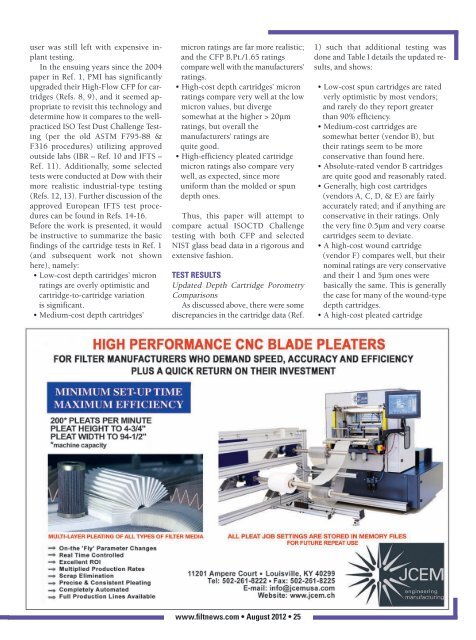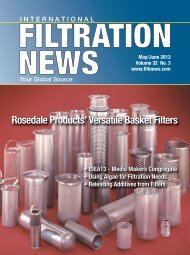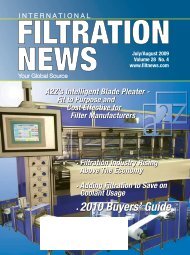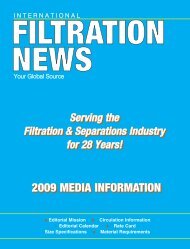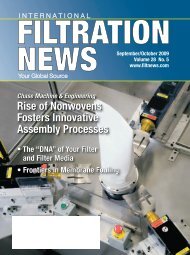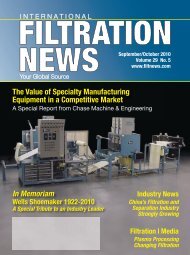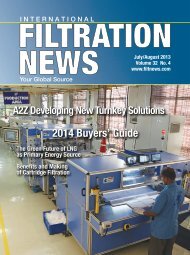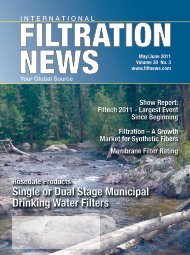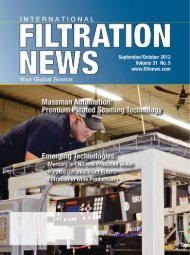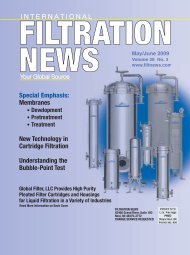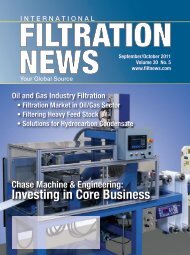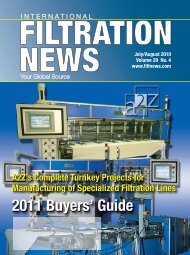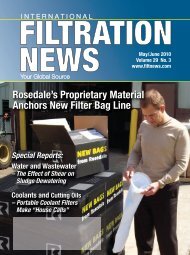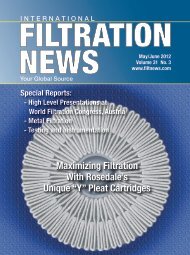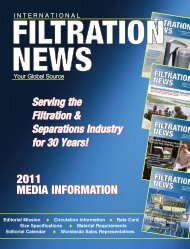2013 Buyers' Guide 2013 Buyers' Guide - Filtration News
2013 Buyers' Guide 2013 Buyers' Guide - Filtration News
2013 Buyers' Guide 2013 Buyers' Guide - Filtration News
You also want an ePaper? Increase the reach of your titles
YUMPU automatically turns print PDFs into web optimized ePapers that Google loves.
user was still left with expensive inplant<br />
testing.<br />
In the ensuing years since the 2004<br />
paper in Ref. 1, PMI has significantly<br />
upgraded their High-Flow CFP for cartridges<br />
(Refs. 8, 9), and it seemed appropriate<br />
to revisit this technology and<br />
determine how it compares to the wellpracticed<br />
ISO Test Dust Challenge Testing<br />
(per the old ASTM F795-88 &<br />
F316 procedures) utilizing approved<br />
outside labs (IBR – Ref. 10 and IFTS –<br />
Ref. 11). Additionally, some selected<br />
tests were conducted at Dow with their<br />
more realistic industrial-type testing<br />
(Refs. 12, 13). Further discussion of the<br />
approved European IFTS test procedures<br />
can be found in Refs. 14-16.<br />
Before the work is presented, it would<br />
be instructive to summarize the basic<br />
findings of the cartridge tests in Ref. 1<br />
(and subsequent work not shown<br />
here), namely:<br />
• Low-cost depth cartridges’ micron<br />
ratings are overly optimistic and<br />
cartridge-to-cartridge variation<br />
is significant.<br />
• Medium-cost depth cartridges’<br />
micron ratings are far more realistic;<br />
and the CFP B.Pt./1.65 ratings<br />
compare well with the manufacturers’<br />
ratings.<br />
• High-cost depth cartridges’ micron<br />
ratings compare very well at the low<br />
micron values, but diverge<br />
somewhat at the higher > 20µm<br />
ratings, but overall the<br />
manufacturers’ ratings are<br />
quite good.<br />
• High-efficiency pleated cartridge<br />
micron ratings also compare very<br />
well, as expected, since more<br />
uniform than the molded or spun<br />
depth ones.<br />
Thus, this paper will attempt to<br />
compare actual ISOCTD Challenge<br />
testing with both CFP and selected<br />
NIST glass bead data in a rigorous and<br />
extensive fashion.<br />
TEST RESULTS<br />
Updated Depth Cartridge Porometry<br />
Comparisons<br />
As discussed above, there were some<br />
discrepancies in the cartridge data (Ref.<br />
1) such that additional testing was<br />
done and Table I details the updated results,<br />
and shows:<br />
• Low-cost spun cartridges are rated<br />
verly optimistic by most vendors;<br />
and rarely do they report greater<br />
than 90% efficiency.<br />
• Medium-cost cartridges are<br />
somewhat better (vendor B), but<br />
their ratings seem to be more<br />
conservative than found here.<br />
• Absolute-rated vendor B cartridges<br />
are quite good and reasonably rated.<br />
• Generally, high cost cartridges<br />
(vendors A, C, D, & E) are fairly<br />
accurately rated; and if anything are<br />
conservative in their ratings. Only<br />
the very fine 0.5µm and very coarse<br />
cartridges seem to deviate.<br />
• A high-cost wound cartridge<br />
(vendor F) compares well, but their<br />
nominal ratings are very conservative<br />
and their 1 and 5µm ones were<br />
basically the same. This is generally<br />
the case for many of the wound-type<br />
depth cartridges.<br />
• A high-cost pleated cartridge<br />
www.filtnews.com • August 2012 • 25


